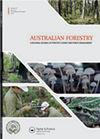亚热带阔叶林树种的小树体积方程
IF 1.2
4区 农林科学
Q3 FORESTRY
引用次数: 1
摘要
摘要:需要对树干体积进行估计,以确定木材产量和森林碳,但对于亚热带的硬木种植物种,缺乏通过易于评估的库存措施来估计体积的方程。我们评估了三个体积方程的优点,该方程结合了对五个硬木种植分类群(柠檬伞菌变种亚种、伞菌杂交种、克隆桉、长叶桉和邓尼桉)的树径和总树高的测量。拟合良好性统计表明,模型1(综合组合变量方程)和模型2(舒马赫和霍尔方程)与数据拟合良好(如调整R2>98)。对不同直径类别的偏差分析表明,这些模型没有显示出任何与树木大小有关的系统偏差模式。模型3(组合可变体积方程)是最不可取的,因为它显示了高估某些分类群中较大树木体积的证据。模型1和2为昆士兰亚热带的五个潜在重要硬木种植物种提供了一组有用的初始体积方程。这些方程基于DBH范围为5−30 cm的茎,因此,随着现有种植园的成熟,需要收集较大茎(>30 cm DBH)的数据。本文章由计算机程序翻译,如有差异,请以英文原文为准。
Small-tree volume equations for subtropical hardwood plantation species
ABSTRACT Estimation of stem volume is needed to determine timber yield and forest carbon, but equations to estimate volume from easily assessed inventory measures are lacking for hardwood plantation species in the subtropics. We assessed the merits of three volume equations that combine measurements of tree diameter at breast height (DBH) and total tree height for five hardwood plantation taxa (Corymbia citriodora subsp. variegata, Corymbia hybrids, Eucalyptus cloeziana, E. longirostrata and E. dunnii). Goodness-of-fit statistics indicated that model 1 (comprehensive combined variable equation) and model 2 (the Schumacher and Hall equation) fitted the data well (e.g. adjusted R 2 > 98). Analysis of bias in different diameter classes indicated that these models did not show any systematic bias patterns with tree size. Model 3 (combined variable volume equation) is the least desirable as it showed evidence of overestimation of volume for larger trees in some taxa. Models 1 and 2 provide a useful initial set of volume equations for five potentially important hardwood plantation species in subtropical Queensland. These equations are based on stems with a DBH range of 5−30 cm and hence there is a need to collect data for larger stems (>30 cm DBH) as existing plantations mature.
求助全文
通过发布文献求助,成功后即可免费获取论文全文。
去求助
来源期刊

Australian Forestry
FORESTRY-
CiteScore
3.70
自引率
4.80%
发文量
15
审稿时长
>12 weeks
期刊介绍:
Australian Forestry is published by Taylor & Francis for the Institute of Foresters of Australia (IFA) for scientific, technical, and professional communication relating to forestry in the Asia Pacific.
 求助内容:
求助内容: 应助结果提醒方式:
应助结果提醒方式:


